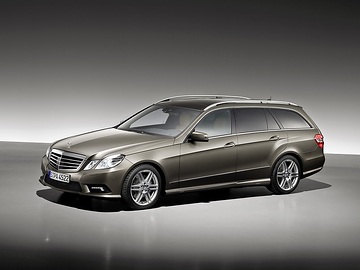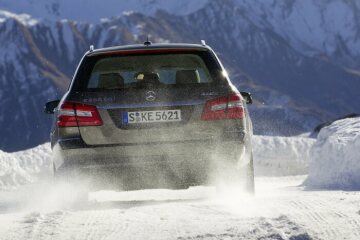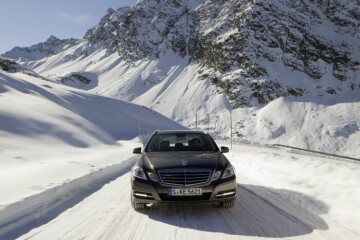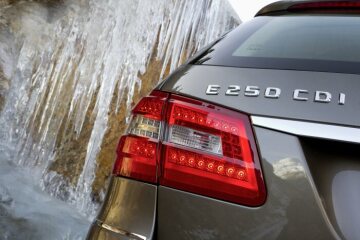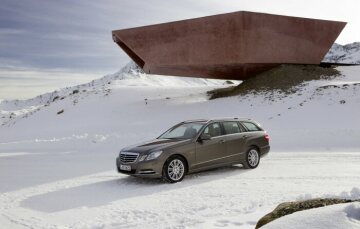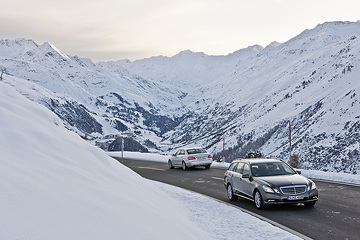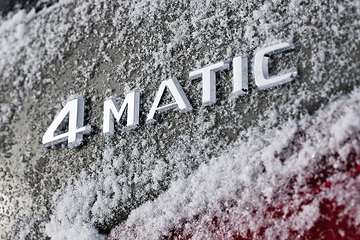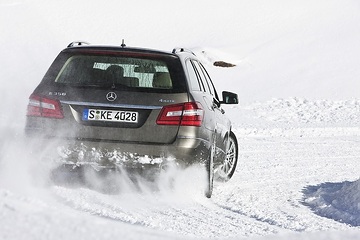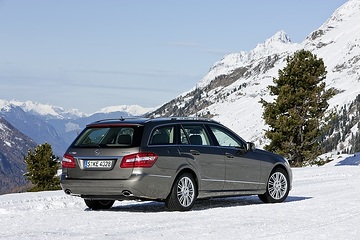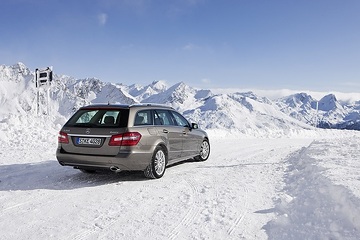After seven years of production of the predecessor series, Mercedes-Benz presented a completely new E-Class in the spring of 2009. The Saloon was presented first, followed in the September by the world premiere of the Estate model at the International Motor Show IAA in Frankfurt/Main. Its outer appearance also showed an underlying tone characterised by its dynamic appeal. The headlamps of the "twin headlamp face", for example, were no longer round but angularly faceted. The design of the rear wings in particular attracted attention, deliberately evoking reminiscences of an early predecessor of the current model, the famous "Ponton Mercedes" from 1953.
The interior was characterised by more a generous sense of space than in the previous generation, and by the use of high-quality materials of natural origin, such as wood and leather. Alternatively, aluminium trim parts of various designs could be specified. Especially in combination with the familiar AVANTGARDE and ELEGANCE equipment lines, there was a wealth of individual design options. Twelve different paint colours were also available.
Particular attention was paid to the load compartment of the Estate model, which, with a capacity of up to 1950 litres, had once again increased compared to its predecessor. To facilitate operation, an automatically opening EASY-PACK tailgate formed part of the standard equipment. The standard equipment also included a new double roller blind as a load compartment cover, attached at beltline height, as well as an EASY-PACK folding floor that could be secured in various positions, making the loading height variable.
The instrument panel of the E-Class set new standards in the competitive environment. The cockpit itself featured five round instruments, with the speedometer containing a two-part central display on which different readings could be called up, depending on the driver's preference. In the centre of the dashboard was the TFT central display with a screen diagonal of up to 7 inches. Here, the functional status of the respective specified infotainment system was presented, the functions of which could be controlled by a controller in the form of a rotary push-button placed on the transmission tunnel trim. Also part of the operating concept of the new E-Class generation was the standard multifunction steering wheel with twelve function keys.
The range of diesel engines available for the E-Class Estate models was new or further developed. The four-cylinder and six-cylinder units were each derived from a basic engine and were available with different output ratings: The four-cylinder basic engine with a displacement of 2143 cc came from the OM 651 engine series and was configured to 125 kW/170 hp in the E 220 CDI BlueEFFICIENCY and 150 kW/204 hp in the E 250 CDI BlueEFFICIENCY models initially available at the start of production. At the beginning of 2010, the E 200 CDI BlueEFFICIENCY with 100 kW/136 hp came in to round off the diesel range at the lower end. Design features such as the latest version of common-rail technology and two-stage turbocharging not only ensured a higher level of performance, but also a significant reduction in fuel consumption values and CO₂ emissions. All output levels of the engine met the Euro 5 emissions standard.
The 3.0-litre six-cylinder diesel from the OM 642 engine series produced 170 kW/231 hp in the E 350 CDI BlueEFFICIENCY and was also certified to Euro 5. With maximum power reduced to 155 kW/211 hp, the V6 engine made the E 350 BlueTEC one of the cleanest diesel vehicles in the world. Thanks to SCR exhaust gas purification technology with AdBlue injection, this engine version already complied with the Euro 6 emissions standard, which tightened the challenge by a further 80 %.
All four-cylinder diesel models were equipped with a six-speed manual gearbox as standard; the six-cylinder models benefited from the 7G-TRONIC seven-speed automatic transmission, which offered efficiency advantages.
For the petrol models, there was a choice of two Euro 5-compliant engines at market launch. The 3.5-litre V6 in the E 350 CGI BlueEFFICIENCY was the world's first petrol engine to feature spray-guided direct injection and, with its 215 kW/292 hp combined with the standard-fit 7G-TRONIC, ensured superior driving performance with low fuel consumption and CO₂ emission values. The V8 in the E 500, with a capacity of just under 5.5 litres, continued to serve as the top-of-the-range engine. The 285 kW/388 hp engine of the M 273 series combined smooth-running with superior driving performance potential and low consumption in keeping with the times.
A little later, two versions of the same four-cylinder basic power unit, also equipped with direct petrol injection as standard, were added to complete the engine range. The 1.8-litre, turbocharged all-aluminium four-cylinder M 271 with variable camshaft adjustment delivered 135 kW/184 hp in the E 200 CGI BlueEFFICIENCY and 150 kW/204 hp in the E 250 CGI BlueEFFICIENCY, both accompanied by significantly reduced standard fuel consumption and CO₂ emissions. In the entry-level model, the power unit was coupled with a 6-speed manual gearbox, in the E 250 CGI BlueEFFICIENCY with a 5-speed automatic transmission.
With the exception of the E 500, all diesel and petrol models on offer were equipped as standard with the BlueEFFICIENCY package of measures, which included numerous detailed fuel-saving technical solutions, particularly among the engine peripherals, such as a demand-controlled configuration of ancillaries. In combination, these measures played a significant part in the overall reduction of fuel consumption by up to 23 % compared to the previous generation.
The first of the all-wheel drive versions for the Estate models of the new E-Class generation were introduced in the first quarter of 2010 and initially comprised the E 350 CDI 4MATIC and E 350 4MATIC. The latest development stage of the permanent Mercedes-Benz all-wheel drive system was coupled with the 7G-TRONIC automatic transmission and featured higher efficiency, more compact design and lower weight.
The DIRECT CONTROL suspension was also further developed. The hydrodynamically operating, amplitude-dependent damping system modulated the respective damping characteristics according to the situation and, together with the front and rear axles that had been revised in detail, ensured a further enhanced comfort experience without compromising the driving dynamics. The hallmark of all Estate models was the standard air suspension on the rear axle, which ensured a constant vehicle height regardless of the load. For the AVANTGARDE equipment line, a sports suspension lowered by 15 mm was available on request. In general, a wide range of optional, differently specified wheel/tyre combinations in 16, 17 and 18-inch formats was available for the new E-Class generation in addition to the respective standard equipment.
A highlight of the new E-Class was the AIRMATIC air suspension system, which for the first time featured a continuously variable electronic damping system and was standard on the E 500 and offered as an optional extra for the V6 diesel and petrol models. Starting from the preselectable basic modes "Comfort" and "Sport", the AIRMATIC system was controlled by sensors to automatically adjust the damping force for each individual wheel depending on the road or driving conditions.
The industry-leading position of Mercedes-Benz passenger cars in terms of safety equipment was also demonstrated by the new E-Class. In addition to the tried and tested systems such as ABS, ESP® and Brake Assist BAS, around a dozen new or further developed driving assistance systems were available as standard or as special equipment. The standard equipment included, for example, ATTENTION ASSIST drowsiness detection and Adaptive Brake Light, while special equipment features included Adaptive Highbeam Assist, Night View Assist PLUS, Lane Keeping and Blind Spot Assist, DISTRONIC PLUS adaptive cruise control, the Intelligent Light System ILS and PARKTRONIC.
The new E-Class generation also came optimally equipped against the effects of accidents in the area of passive safety. The passenger compartment was designed to be almost non-deformable, with features that included continuous longitudinal side members and a main floor composed of different material thicknesses. More than 70 % of the body panels were made of high-strength steels. The elaborate overall design of the bodyshell ensured that torsional rigidity improved by over 30 % compared to the previous generation. In order to keep an eye on the overall weight of the body nevertheless, the bonnet and front wings were made of aluminium. In the interior, seven airbags and crash-active NECK-PRO head restraints completed the safety package.
At market launch, the gross list prices of the new E-Class Estate models ranged from 44,803.50 euros for the E 220 CDI Blue EFFICIENCY to 70,150.50 euros for the top-of-the-range E 500 model.
In summer 2009, AMG presented its performance version of the new E-Class Estate. At the heart of the E 63 AMG was the V8 from the M 156 series with a displacement of roughly 6.2 litres. The 386 kW/525 hp engine, designed according to the high-rev concept, was one of the world's most powerful naturally aspirated passenger car engines. As a result, the E 63 AMG completed the sprint from zero to 100 km/h in 4.6 seconds; the top speed was electronically limited to 250 km/h. Power transmission was handled by the AMG SPEEDSHIFT MCT 7-speed sports transmission, with a start-off clutch running in an oil bath replacing the hydraulic torque converter. Three different preconfigured driving modes as well as one manually definable one could be selected. The transmission's range of functions included, for example, extremely short shift times, an automatic throttle blipping function when downshifting and a RACE START function. Despite the higher overall performance of the drivetrain, a reduction in the combined standard fuel consumption of around 12 % was achieved.
In keeping with the performance capability of the new E 63 AMG, the standard AMG RIDE CONTROL sports suspension was upgraded with a new electronic damping system that provided suspension modes of varying characteristics, as well as a newly developed front axle with 45 mm wider track, reserved for the performance model. The estate-typical air suspension at the rear axle was retained. For particularly demanding use, a ceramic composite brake system weighing 40 % less and with higher stress resistance was available as an option.
The exterior appearance of the E 63 AMG was characterised by a new front apron, widened front wings with "6.3 AMG" lettering, special side sill panels, a new rear apron and the quad sports exhaust system. AMG light-alloy wheels measuring 9 J (front) and 9.5 J x 18 (rear) with 255/40 and 285/35 tyres completed the look. In the interior, special sports seats, a sports steering wheel with gearshift paddles and other sporty, functional details created a typical AMG ambience. In terms of safety equipment and driving assistance systems, the E 63 AMG Estate was on the same high level as the other models of the new E-Class generation. In the price lists, the performance saloon started at a gross list price of 108,409.00 euros.
At the Geneva Motor Show in March 2010, Mercedes-Benz presented the E 250 CDI BlueEFFICIENCY with optional 7G-TRONIC automatic transmission. Efficiency-enhancing measures such as a standard ECO automatic start/stop system and further optimisations to the engine's inner workings and peripherals resulted in an average reduction in fuel consumption of around 15 %.
The next innovation steps followed from summer 2011. The 3.5-litre six-cylinder in the E 350 BlueEFFICIENCY now benefited from the use of the newly developed BlueDIRECT technology, the heart of which was its third-generation direct petrol injection system with spray-guided combustion and 200 bar injection pressure. Despite an increase in peak power to 225 kW/306 hp, the BlueEFFICIENCY package of measures reduced average standard fuel consumption by up to 20 %. In this context, the E 500, which was subsequently offered as the E 500 BlueEFFICIENCY, underwent a particularly far-reaching overhaul. Instead of the previous 5.5-litre naturally aspirated engine of the M 273 series, a V8 from the M 278 series with a displacement of nearly 4.7 litres, biturbo charging and likewise BlueDIRECT injection technology was used. The state-of-the-art power unit delivered a peak output of 300 kW/408 hp and - also benefiting from the BlueEFFICIENCY measures - showed a reduction in combined average fuel consumption according to the NEDC standard of around 17 %.
All four-cylinder engines in the range, both diesel and petrol, now featured the ECO start/stop function as standard, and the 7G-TRONIC automatic transmission was now the only option available for E-Class vehicles equipped with a manual transmission. Depending on the equipment, the four-cylinder BlueEFFICIENCY models E 200 CDI, E 220 CDI, E 250 CDI as well as E 200 and E 250 - the latter two had lost the additional designation CGI - achieved fuel consumption reductions of up to 16 % according to the NEDC standard.
At the same time, the E 63 AMG Estate was also equipped with a new power unit. Instead of the previous naturally aspirated V8 engine, a biturbo eight-cylinder from the M 157 series with a displacement of now only 5.5 litres but identical output of 386 kW/525 hp and a maximum torque of 700 Nm was installed. Among other things, the engine featured the latest generation of spray-guided direct petrol injection and boasted over 20 % lower average fuel consumption according to the NEDC standard. An AMG Performance Package was available as an option, offering an increased peak power of 410 kW/557 hp and 800 Nm. The top speed, still limited to 250 km/h, could optionally be raised to a likewise electronically governed 280 km/h.
From the outside, the performance estate with this new engine was recognisable by its differently designed AMG light-alloy wheels and "V8 Biturbo" lettering on the front wings. In the interior, the new AMG Performance steering wheel with flattened rim and the new TFT colour display in the speedometer were among the striking features.
In March 2012, Mercedes-Benz presented its first diesel hybrid vehicle, the E 300 BlueTEC Hybrid. The familiar four-cylinder OM 651 diesel engine in its 150 kW/204 hp configuration was combined with a hybrid module as the drive system. Its 20 kW/27 hp electric motor supported the diesel engine during acceleration, was used in generator mode to recover braking energy and also enabled all-electric driving to a limited extent. The modular hybrid system, consisting of an electric motor, 7G-TRONIC transmission with wet start-off clutch and a lithium-ion energy storage system, weighed only around 100 kg and made the E 300 BlueTEC Hybrid, both as a Saloon and as an Estate, the most economical luxury-class vehicle in the world and at the same time the one with the lowest CO₂ emissions.
Compared to the Saloon, the Estate achieved significantly lower production figures in the first production cycle that ran until the facelift in spring 2013. Less than 17 % of the total of around 800,000 vehicles built of the W and S 212 model series during this period were 5-door models. The clear leaders in the production statistics were the four-cylinder diesel models, first and foremost the E 220 CDI BlueEFFICIENCY Estate with almost exactly 30,000 units. The E 200 CDI BlueEFFICIENCY and the E 250 CDI BlueEFFICIENCY followed, with just over and under 16,000 vehicles respectively. The E 500 or (from the beginning of 2011) E 500 BlueEFFICIENCY, E 500 4MATIC BlueEFFICIENCY and E 63 AMG versions were the least popular with customers of the Estate model, with production figures remaining in the three-digit range until the facelift.









